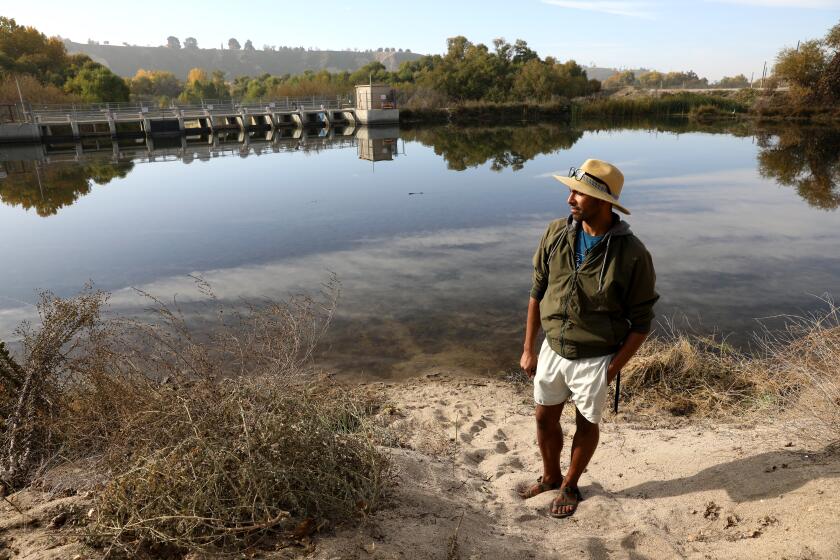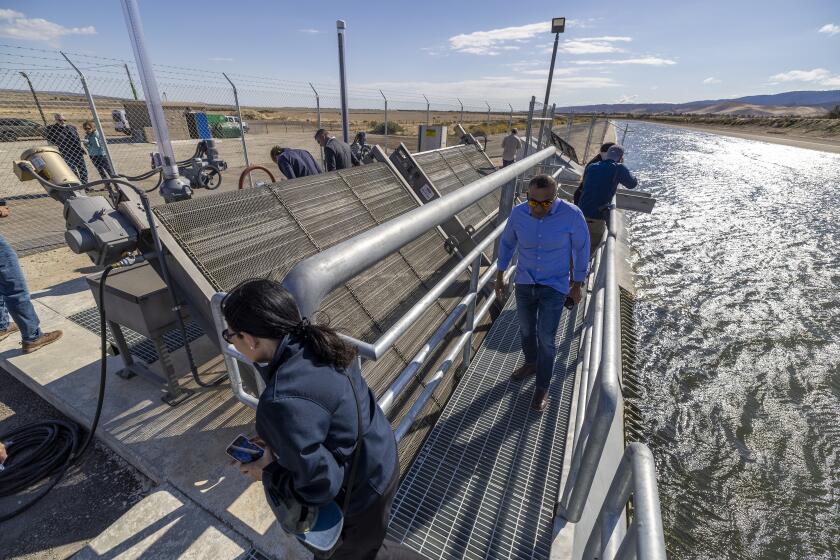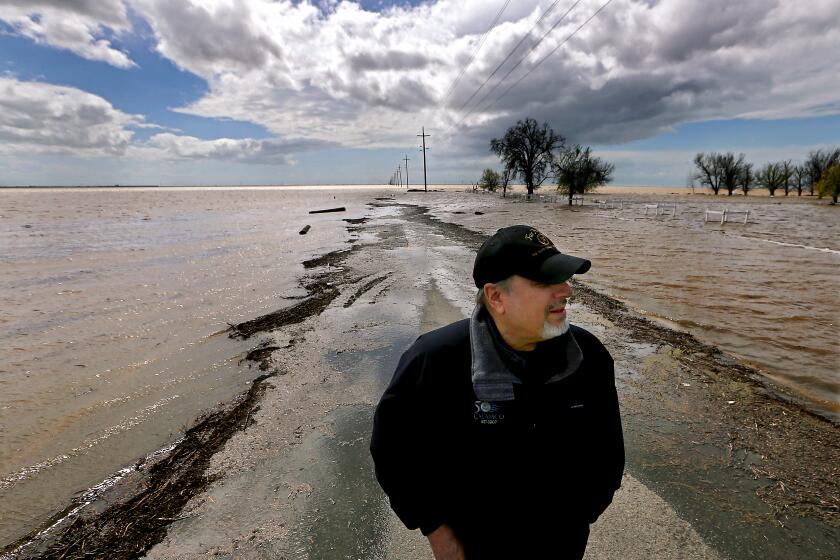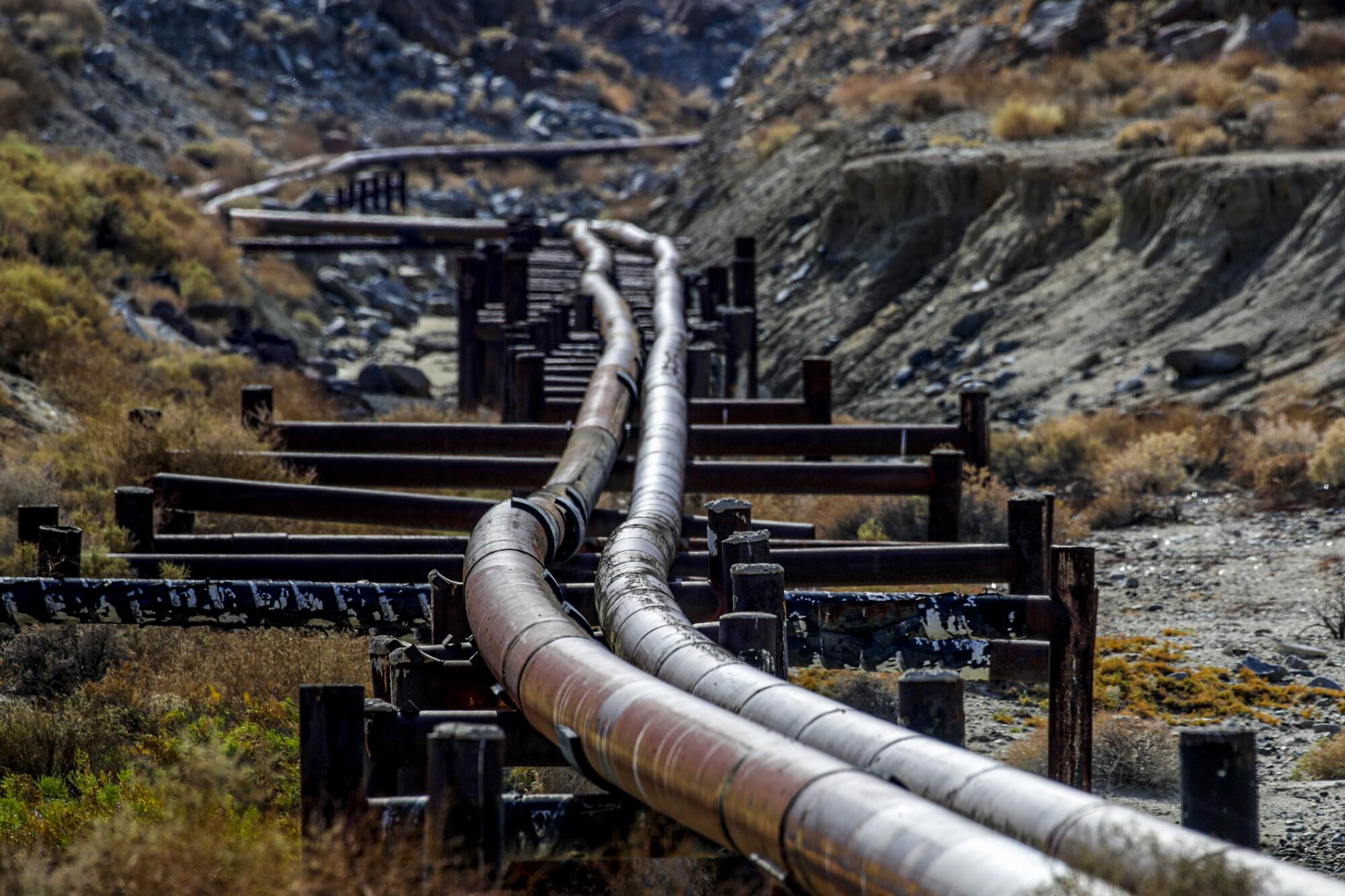
- Share via
RIDGECREST, Calif. — After decades of unrestricted pumping in the rain-starved northwestern corner of the Mojave Desert, the Indian Wells Valley Groundwater Basin Authority has the distinction of managing one of the most critically overdrawn aquifers in California.
Now, the region is in an uproar over a proposal that the authority sees as a way out of its groundwater crisis, one that critics say would give priority to urban consumers in the city of Ridgecrest and the adjacent Naval Air Weapons Station China Lake over farmers and mining operations.
Aggressive and impactful reporting on climate change, the environment, health and science.
It’s a $200-million, 50-mile-long pipeline system that would move water from the California Aqueduct in California City — over arid desert mountains — to a storage tank in the urban center of Ridgecrest.
The federal government would pay $150 million of the cost, authority officials say, with the remaining $50 million passed on to ratepayers, including pistachio growers and mining operations recently saddled with a special “groundwater replenishment fee” of up to $6 million a year.
That does not include the potentially formidable costs of acquiring water to be conveyed through the pipeline, planning, annual operation and maintenance, officials said.
To hear the authority tell it, the days when landowners could dig a well in Indian Wells Valley and pump to their heart’s content, so long as the water was put to a beneficial use, are over.
“The farmers and mining companies are filing lawsuits against us because their groundwater isn’t free anymore,” said Keith Lemieux, who serves as both Ridgecrest city attorney and groundwater authority counsel. “But we cannot continue overdrafting the region’s most important source of fresh water.”
To do so, he said, risks a potential takeover by state officials. That’s because state law requires that local agencies bring groundwater aquifers into balanced levels of pumping and recharge.
The small desert town of Trona imports its water from 30 miles away. A 2014 law aimed at preserving California’s groundwater has set off a complicated battle that has some residents fearing the worst.
The amount of water currently flowing into the valley’s underground basin is 7,650 acre-feet a year. Annual usage is about 28,000 acre-feet. Eight wells have gone dry in the past year, and about 800 are at risk, officials said.
But this is no classic stop-the-overdraft battle.
The Indian Wells Valley aquifer lies under a point in the eastern Sierra Nevada range landscape where the corners of San Bernardino, Kern and Inyo counties meet.

In 2019, the Naval Air Weapons Station China Lake, which generates $36 million in state and local taxes and represents a large portion of the local economy, said its top concerns include encroachment on groundwater, suggesting that shortages of its sole source of potable water could force it to shut down and move away.
“Without the base, there’s no Ridgecrest,” Lemieux said. “We have to have more water.”
Conservation groups sued to try to prevent the Kern River from running dry in Bakersfield. A judge ordered the city to ensure water remains in the river.
Draining the aquifer would also sink Ridgecrest’s hopes of a bustling future of new homes, restaurants, and businesses for the 5,900 scientists, engineers and contractors employed at China Lake, which is undergoing about $4 billion worth of upgrades prompted by the 6.4. 5.4 and 7.1 magnitude quakes that rocked the area in 2019.
“I don’t see Ridgecrest turning into the next Las Vegas or Victorville, but it could benefit from some additional development,” said Carol Thomas-Keefer, general manager of the groundwater authority.
“More importantly,” she said, “the pipeline is a solution to a chronic problem: Wells are going dry because folks are tapping the aquifer’s supply of fresh water faster than it is being returned to the basin naturally by rain and snowmelt off the Eastern Sierra Nevada range.”
That kind of talk has prompted Searles Valley Minerals, in the community of Trona, and Mojave Pistachios, a tree nut company on the west side of Ridgecrest, to rise up in a fury, declaring the proposed pipeline is part of a groundwater sustainability plan that forces them to bear an allegedly unfair and illegal economic burden that threatens their continued existence.
A new water storage facility in the desert will bank supplies underground for Southern California in an effort to help the region adapt to climate change.
“It’s a pipe dream — one so bizarre it’s almost laughable,” said Amy M. Steinfeld, an attorney representing Mojave Pistachios, whose 210,000 trees materialized like a green oasis about a decade ago across 1,600 acres of scorched desert.
“They’ve completely ignored numerous alternatives that would meet their goals while substantially decreasing the financial costs and environmental impacts,” she said.
Tensions have already flared over an aquifer “replenishment fee” of $2,130 per acre-foot imposed on a select few users by the groundwater authority in 2021. That increased the water costs for Mojave Pistachios and Searles Valley Minerals by as much as $6 million per year.
The China Lake base, one of the largest users of water in the valley, has federal reserve water rights that make it exempt from the replenishment fee and pipeline costs passed on to ratepayers.
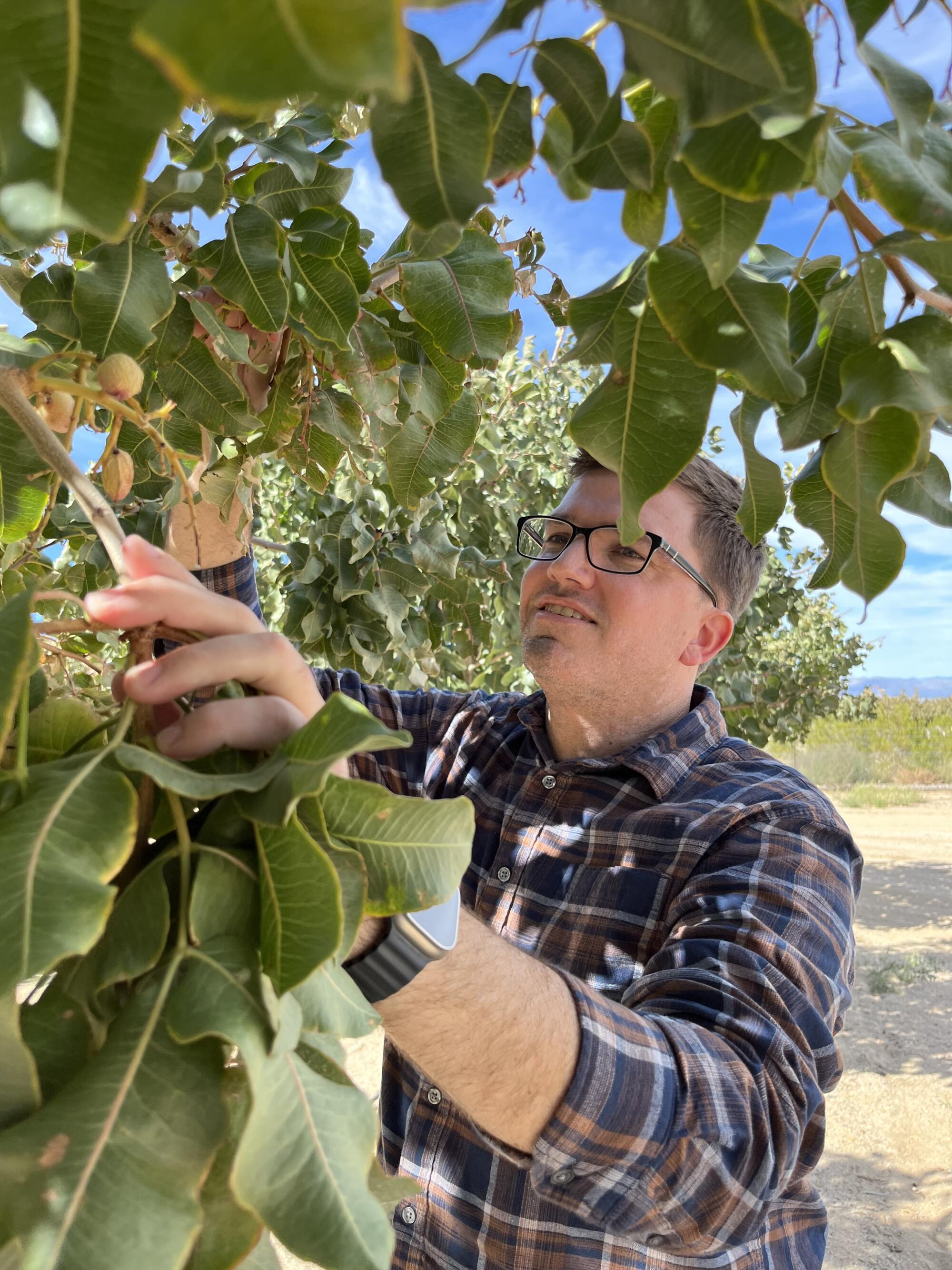
“This fee is like saying everyone has a right to drive a Lamborghini — if they can afford one,” said Joshua Nugent, a spokesman for Mojave Pistachios.
Claiming that it deprives them of their water rights and could put them out of business, both Mojave Pistachios and Searles Minerals are defying an order to pay the fees or cease pumping. The water district in Indian Wells Valley is also being charged but is making its payment under protest.
Drought has long been the norm for California. But the state had a historically wet winter, and El Niño is threatening again.
Their cases, which are being heard in Orange County Superior Court to avoid claims of bias, have the potential to be landmark litigation as new groundwater regulators throughout the state consider how best to implement the state Sustainable Groundwater Management Act of 2014.
The battle has spawned a good bit of anxiety in Trona, a withering town of 1,500 residents in a wind-swept bowl hugged by three rugged mountain ranges that relies on groundwater supplied by Searles Valley Minerals.
Searles officials say the authority’s decision to single it out with the hefty replenishment fee, along with proposed rate increases related to the pipeline, could push the company out of business after more than 140 years of operation, putting its 700 employees out of work and turning Trona into a historical footnote.
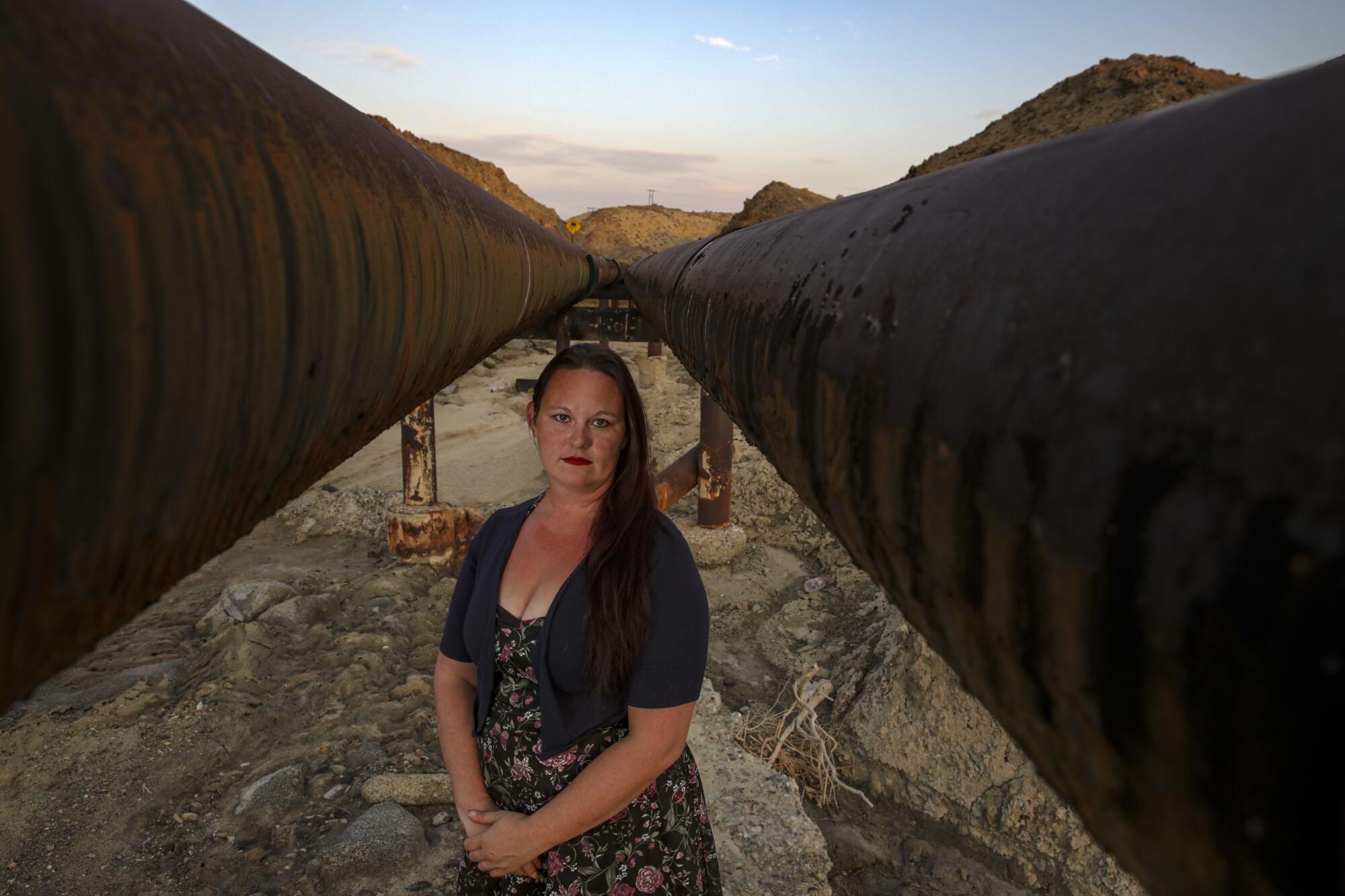
“With no Searles, there’s no Trona,” said Regina Troglin, 35, a resident and freelance architectural designer.
“Just because Ridgecrest wants to grow doesn’t mean it has the right to kill off Trona,” she said. “If the authority and Ridgecrest were serious about sustaining groundwater, they’d be pushing for storm water recovery, greywater recycling systems, and lawn removals.”
The pipeline plan has also sparked challenges from environmentalists and the California Department of Fish and Wildlife.
The first winter outlook from the National Oceanic and Atmospheric Administration predicts that a strong El Niño will remain in place through at least the spring, bringing warm, wet conditions to California and large swaths of the U.S.
That’s because it would cut a zigzag path from a starting point at the Antelope Valley-East Kern Water Agency feeder pipeline in California City through historical habitat for wildlife including mountain lions, state and federally threatened desert tortoises and state threatened Mojave ground squirrels, chubby rodents with big eyes that advocates like to say resemble “happy little Buddhas.”
A particular concern is hybridization with round-tailed squirrels, which use disturbed areas as population expansion opportunities and have been moving westward from the Barstow area.
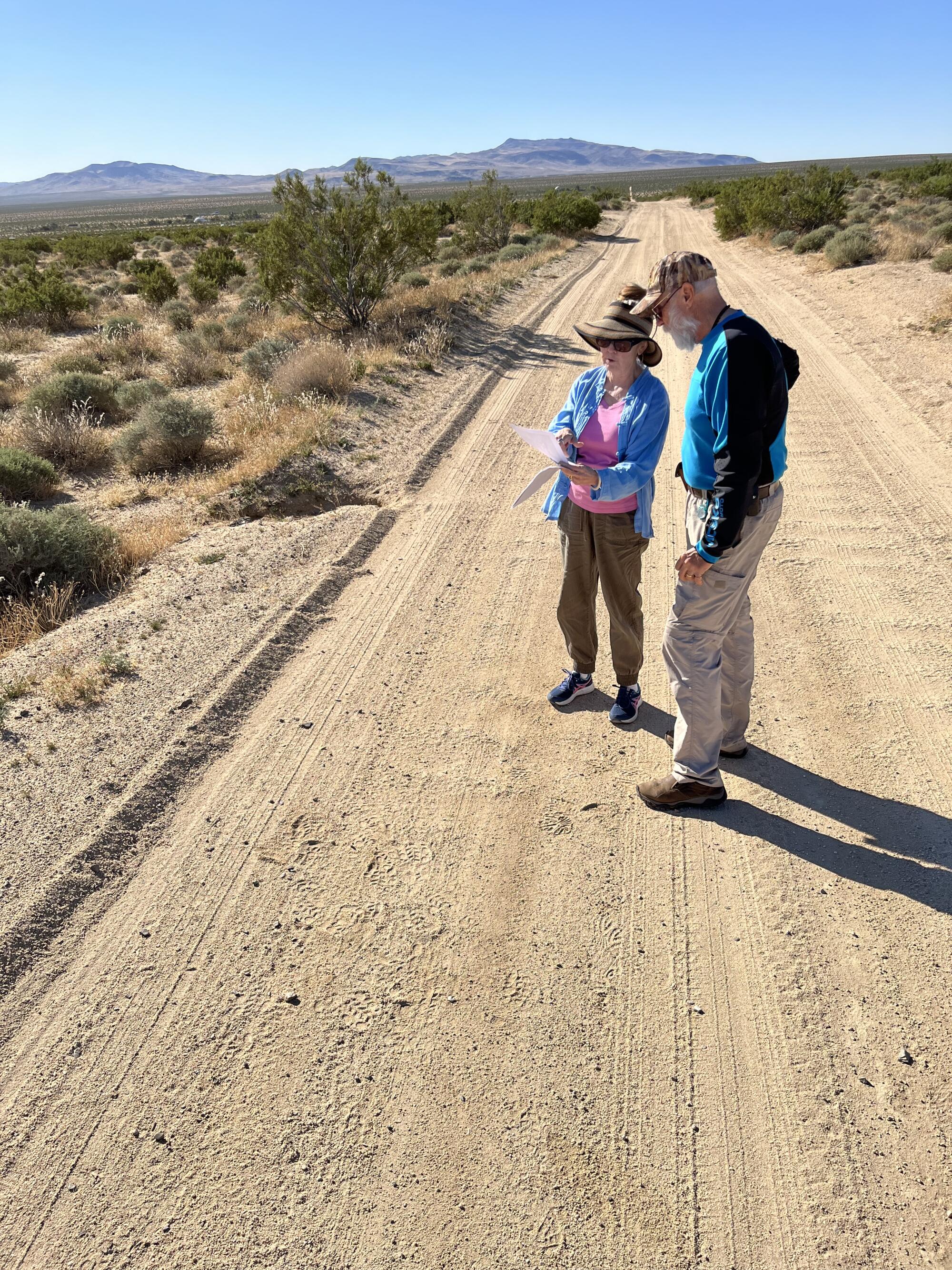
High on a bluff overlooking Indian Wells Valley, Ileene Anderson, a senior scientist with the Center for Biological Diversity, gazed out over the bone-dry desert valley born of seismic upheavals, flash floods, drought and heat.
“It’ll be a tough fight, but we’re not going away — there are a lot of unanswered questions regarding the pipeline’s impacts on wildlife and plants,” she said. “We’re not convinced that importation of water over long distances is even sustainable over the long term under climate change scenarios for California.”
More than a decade after California passed the Human Right to Water Act, about 1 million residents still lack access to clean, safe, affordable water.
That debate took a surprising turn in August when tropical storm Hilary triggered flash floods that washed out county roads in the proposed site of three booster pump stations necessary to push water in the pipeline over the El Paso Mountains.
But backers of the pipeline said flood risks go with the territory, especially in arid mountainous regions, and could be resolved through mitigation.
“We’ll just put the pipeline a little deeper in the ground,” said Don Strand, Ridgecrest city manager.
A more pressing question, he said, is whether proponents can secure funding for the controversial proposal.
“If we can’t afford the pipeline, we have a big problem,” he said.


